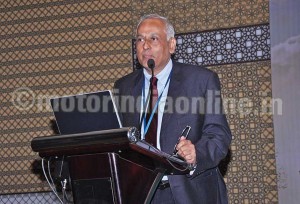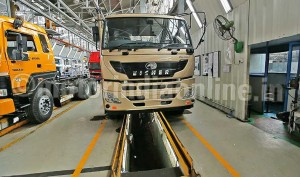
The Indian commercial vehicle industry has undergone a thorough transformation in the last one decade with a large number of players, both Indian and overseas, expanding their operations on a regular basis to meet the ever-rising demand, and the number of vehicles of different models and types plying roads increasing at an accelerated rate. Side by side, competition among vehicle manufacturers is hotting up with all of them stretching their means to the utmost to gain a bigger market share. This is in striking contrast to the duopoly market of the past 30-40 years.
Addressing the 3rd India Commercial Vehicle Summit in Pune, Mr. Shyam Maller, Senior Vice President, Sales and Marketing, VE Commercial Vehicles Ltd. (VECV), said the future of Indian trucking and CV market is bright indeed. In spite of it being the largest democracy, India is politically and economically stable and its progress rapid. Since the CV industry is the barometer of the economy, the Government has been focusing on infrastructure development.
However, he said, overloading is posing a great threat to Indian roads and is a major cause of a large number of fatalities in road accidents. “Though with strict regulations, this practice is changing, it is still predominant in the construction industry. There is again a huge amount of pressure on the manufacturer to design the trucks according to the customer’s perception. Of course, third generation truckers are far more rational with a good knowledge of the prevalent worldwide trend.
In India, since 50-60 per cent of the operational cost of trucks is spent on fuel, automotive OEMs need to focus on fuel-efficient products to be more successful in their operation. With the emission norms becoming more stringent in the country as compared to large markets in the Middle-East and Indonesia where the norms are very low, trucks, though a bit costly, are becoming more fuel efficient.”
Commenting on the aftermarket, Mr. Shyam said: “We have a large industry of road side mechanics to whom customers are used to going around and getting their vehicles repaired. With changing technology and vehicles getting more sophisticated, this trend is also changing. The role of the dealership is becoming even more important. When the BS-IV norms are enforced and when the new technology becomes difficult for a roadside garage or a make-shift workshop, they would find the going difficult to maintain.”
Large companies in the logistics and warehousing space in India are working on goods and service tax (GST) which is a huge driver for change as far the commercial vehicle industry is concerned. The advantages of implementing GST are reorganising warehousing space in India, and a large hub development in key locations coupled with smaller spoke centre near to production and consumption centre.
 As for truck drivers who are possibly the most neglected lot, he said there is very little done by OEMs and fleet owners for their welfare. The driver community that continues to be underpaid undergoes a lot of ill-treatment. Driver training has always been a lip service given by a lot of OEMs and customers. Thus, as this profession is ceasing to become a real challenge, there is a crucial need for efficient drivers in order to sell more trucks. Also needed are ergonomically designed trucks.
As for truck drivers who are possibly the most neglected lot, he said there is very little done by OEMs and fleet owners for their welfare. The driver community that continues to be underpaid undergoes a lot of ill-treatment. Driver training has always been a lip service given by a lot of OEMs and customers. Thus, as this profession is ceasing to become a real challenge, there is a crucial need for efficient drivers in order to sell more trucks. Also needed are ergonomically designed trucks.
Addressing the problem of trained drivers and vehicle life cycle profitability, Mr. Shyam observed: “At VECV we are proud to say that every vehicle we sell we provide a trained driver. We are trying to build a lot of ergonomics into the trucks. A most modern technology gets into the making of a truck, of course with Volvo technology. The truck’s cabin plays a huge role in the future in every OEM strategy. As for the fleet operators, they need to have good drivers who can deliver the best performance of the truck in terms of their ability to drive more distance with better fuel performance. Oil companies have come up with products with increasing drain intervals. We have also improved our engines as well to ensure that the scheduled visits to the workshops come down. Also, with the Government incorporating weigh bridges on State boundaries, fleet operators are very clear that the payload of the vehicle has to be as high as possible since profitability is directly linked to the payload.”
According to him, the resale value of a vehicle is another important element OEMs need to concentrate on. “When we at VECV meet the customer, we try to explain to them what vehicle lifecycle profitability is all about. Resale value of the vehicle is built-in in the form of a better and higher durability truck which lasts longer and of course performs well”.
Highlighting the importance of fully-built trucks which have a huge opportunity, Mr. Shyam said telematics which is extremely useful is happening in the CV industry. There are a whole range of features like fuel management, remote diagnosis, etc., that are getting built into trucks that will improve their performance.